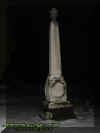|
|
||

Waterford Cemetery in my opinion is a must see. It is one of these old civil war historic types of cemeteries in the town of Waterford PA. I had ALOT of fun walking around here despite the snow and cold weather. Below further I posted a history on the town of Waterford I did not write it but the towns history is closely related to the cemetery they go hand in hand. Alot of the stones here are from the earlier 1800s the oldest section sits up on a hill and the graves are so close that they are almost touching just an inch apart. The photos from this excursion came out really great I think our fans are going to enjoy this. After our investigation of the cemetery Jim and I got to drive right through the historic part of town and grab some coffee so this turned out to be a well worth trip. One of the graves that stands out in the cemetery is one with a plaque and a cannon which was one of Waterford's leading citizens. His gravesite is located under a large tree right smack in the middle of this giant cemetery. He served in the provincial army in the French and Indian War of 1753-1763 and later was in the Revolutionary War. He volunteered to fight again in the War of 1812 which mainly took place around the Buffalo NY area but was rejected cause he as 85 years of age. At the age of 100 years old he founded a school in Waterford and by the age of 115 years old he died from Pneumonia. I am so amazed by this story this was a man with such great strength and courage. Even living to 115 has to say something. But this is just one of many historic figures buried within the cemetery. How about Bea Canfield who had a local show on NBC in Erie PA. It was called the Bea Canfield Show during the 1970s. She is buried here as well. Then their is another burial by the name of Jean Lovell Dowler who was a catcher for the Rockford Peaches she was buried with her catcher's mitt. Each person within the cemetery has a story to tell that is what makes this place so interesting to investigate. © By Lord Rick-AngelOfThyNight History Waterford Township was making history long before the first surveyors or settlers came to northwestern Pennsylvania. In their effort to dominate the New World, the French built a series of forts along a route that extended from Canada to Louisiana. The first, built in 1753, was near Lake Erie (Fort Presque Isle), and the second, built that same year, was at the head of LeBoeuf Lake. A portage road (now Old French Road) was cut through between the forts and from Fort LeBoeuf, supplies were sent down French Creek. It was at Fort LeBoeuf that young George Washington came in December 1753 to deliver a message from Robert Dinwiddie, Great Britain's Governor of Virginia, telling the French to abandon their claims. Washington also was to determine the strength of the enemy. In 1756 England declared war on France and in 1759 the French deserted the forts and left them burning. The
following year the British rebuilt the forts and held them for three years
until the Seneca and Delaware Indians raided and burned them. Not
until after the American Revolution, until after many battles were fought
and many treaties were signed between the Americans and the tribes of the
Six Nations, was it safe for settlement in the lake region.
The township was and remains the largest in the
county. Its officials claim it was organized when the nation won its
independence. In 1780, lands in this area that begin about one mile
east of today's Waterford Borough were reserved as the 10th
Donation District, which continued across the county from the old state
line to Warren County. These were lands given to the officers and soldiers
of the Revolutionary War who were from Pennsylvania in exchange for their
considerable service to their newly established country. Some
veterans chose to sell off their land: some sold to land companies; others
sold to individuals. The land was not safe for settlement for more
than a decade.
Surveying began in 1794 and some of the soldiers
assigned to protect the surveyors chose to return and settle in Erie
County. One was Capt. John Grubb who later settled in Millcreek
Township and rose to considerable prominence in the county. Others
who settled in Waterford Township included Lieutenant Martin, Capt. Martin
Strong, Amos Judson, John Vincent, and more.
The salt trade was an important factor in the
early development of the township. Salt was mined in New York State
and transported in barrels by boat to Erie. From there it was
portaged over the old French trail to warehouses near Waterford where it
was stored until the waters of French Creek were sufficient for floating
flatboats. The land route was often in deplorable condition and difficult
to travel. About 1806 work began on an improved turnpike from Erie to
Waterford and was completed in 1809. The salt trade thrived from 1800 for
nearly two decades when other salt mines were discovered nearer the
markets.
A weekly mail service between Erie and Pittsburgh
began in 1801 and soon a stagecoach line began operation on the turnpike
road. Waterford Township, located near the middle of the county, was
along the way from many hamlets to many others and several early roads
were cut through.
In 1859 the Philadelphia and Erie Railroad rolled
through and a depot was built east of the Borough of Waterford.
Called Waterford Station, the small community that developed here included
the station building, a hotel with a grocery supply, a sulky rake factory,
a warehouse and ice house, a schoolhouse, a Catholic Church, and about two
dozen dwellings of various quality. The railroad company had
stockyards here and this became one of the most important stations along
the line for shipping cattle and produce.
Other clusters of buildings that developed into
hamlets were in the southwest corner, such as Phelps Corners, and a few
miles north of there, called Bagdad. None of these hamlets remain as
anything more than points on a map today.
The township's most fertile land for farming was
south of Waterford Borough, near Lake LeBoeuf. Just about any kind
of crop can be grown here, although the area is quick to frost.
Two of the most successful of the crops today are strawberries and
potatoes. The large Troyer Farms processes the latter and is known
for its chips with a market in many states.
|
|
|
|
|
|














